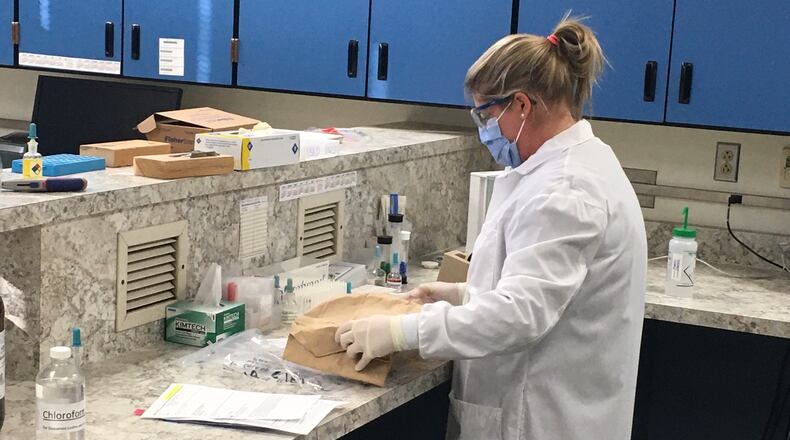The argument: One Ohio puts state and local governments in a strong position and it’ll give local governments a say over how settlement money is distributed and spent.
The documents don’t share a specific settlement but do show the proportions for how a settlement would be divided out.
Based on the guidelines and a $1 billion settlement, Montgomery County would receive $46.9 million, the most in this region. Dayton would receive $12 million and Warren County $9.5 million and Greene County $8.2 million. Clark County would receive $11 million
FIRST REPORT: Deal in the works for Ohio to settle massive opioid lawsuit
More than 2,600 lawsuits were filed against opioid makers and distributors, which many U.S. communities blame for fueling the epidemic.
DeWine said a united front would better position Ohio in settlement negotiations and would more likely lead to more money that can be used to fight current and future addiction crises.
“I’m very enthusiastic about this plan. It’s the right thing to do for Ohio’s future,” the governor said Thursday.
The opioid settlement is state and local governments’ big chance to recoup money spent on the devastating public health crisis that that left thousands dead, thousands more still in active addiction, and thousands more Ohioans working to maintain their hard fought recovery.
In 2018 alone, 3,764 Ohioans died of unintentional drug overdoses, with 3,150 of those involving some type of prescription or illicit opioid. The costly crisis overburdened police, social service agencies, and treatment centers.
PREVIOUS COVERAGE: Billions at stake in massive opioid settlement proposal
Under the One Ohio agreement, 11% would be taken off the top for attorney fees and the remaining cash would be divvied up — 30% for local governments, 55% to a new foundation and 15% to the attorney general’s office.
The foundation would be controlled by a 25-member board appointed by state, legislative and local officials. It would spend settlement money to address the opioid epidemic both locally and statewide.
“From the state’s point of view, we’re in a better negotiating position if we have a unified position. We have a larger voice in the national discussion. The most important thing is the value it brings for the locals,” Yost said in an interview Thursday.
The state has two lawsuits, pending in Ross and Madison counties, that are set for trials in August and October, Yost said. More than 150 Ohio local governments are part of a consolidated case pending in U.S. District Court before Judge Daniel Polster in Cleveland.
Yost said some of Ohio’s larger municipalities still have concerns about the One Ohio structure but he declined to disclose which cities are on the fence.
RELATED: How cities and counties could reach giant opioid settlement
“I think we’re most of the way there. It just depends on if we can get a critical mass,” he said.
Inking the deal for One Ohio is the first step. The bigger step is to negotiate a settlement agreement with defendants in the state’s cases and the local governments’ cases, Yost said.
The proposed framework for One Ohio includes amounts that would be delivered to local governments if the state were to land a $1 billion settlement — a purely hypothetical number at this point. The money would be spent on costs associated with the opioid crisis.
The biggest metro areas stand to receive the most. Cuyahoga County would get $60.8 million; Hamilton County, $53.2 million; and Franklin County, $52.6 million. Meanwhile, smaller jurisdictions would get smaller amounts: $56 to Milton Center Village in Wood County and $207 to Potsdam in Miami County.
Estimates of how much the opioid crisis cost have varied. A 2017 Ohio State University study estimated opioid addiction, abuse and overdose deaths cost Ohio from $6.6 billion to $8.8 billion a year. That’s about as much as the state spends on K-12 education.
Based on the guidelines and a $1 billion settlement, the following local governments would receive the most money:
Montgomery County, $46.9 million
Dayton, $12 million
Warren County, $9.5 million
Greene County, $8.2 million
Miami County, $5.2 million
Miamisburg, $1.5 million
Fairborn, $1.4 million
Miami Twp, $1.2 million
Washington Twp, $1.2 million
Beavercreek Twp, $1.2 million
Xenia, $1.1 million
Vandalia, $879,469
Clearcreek Twp. , $794,905
Riverside, $743,538
Trotwood, $737,978
Oakwood, $604,881
Englewood, $570,979
Butler County, $24.4 million
Hamilton, $6.1 million
Middletown, $5.3 million
West Chester Twp., $3.4 million
Liberty Twp, $1 million
Oxford Twp., Butler County, $1 million
Fairfield Twp., $728,334
Oxford, $722,458
Clark County, $11 million
Springfield, $4.3 million
Champaign County, $2 million
Urbana, $522,893

